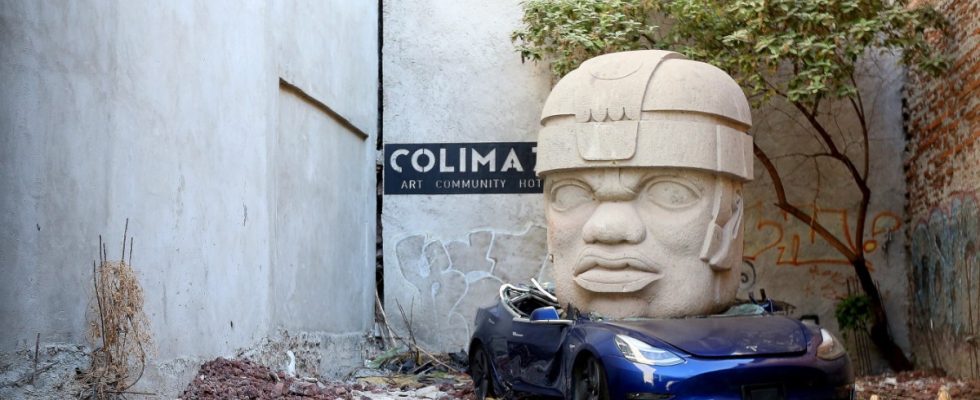If you want to understand why Tesla sales figures are so disastrous; why Dan Ives from venture capitalist Wedbush Securities even describes it as a “train wreck, crashing into a brick wall at full speed”; why the electric car manufacturer’s shares have fallen by more than a third since the beginning of the year: Tesla design studio in Los Angeles, May 2015. There are only Teslarati there, i.e. Tesla and Elon Musk disciples, and they are: inspired.
Inspired by Musk, who at the time came across as an Iron Man-like world saver and explained to those present his vision of Tesla as a battery and energy-saving company. Inspired by plans to build several at once Gigafactories worldwide, including in Germany – and of course also inspired by yourself: As a Tesla driver and possibly a stockholder, you were contributing your part to the revolution in the automotive industry and to climate protection for everyone to see.
Tesla is now one electric car manufacturer among many
Almost nine years later, the only people who still care about Musk are people who think it’s great what he’s doing with the social network The magic surrounding Tesla also seems to have worn off; no one has called Tesla a battery or home power company for a long time. The group is now one of many electric car manufacturers that, like all listed companies, publishes figures every quarter and is measured against them. The narrative is no longer that the swashbuckling Musk is investing his fortune to, as he said at the time, “save that blue or green ball or expand life sooner or later so as not to die out.” Okay, admittedly: a launch of a Space
Back to Tesla: The crucial number is 386,810. That’s how many vehicles the company delivered in the last quarter. Mind you: delivered – not produced; Because the difference is about as big as whether you think Musk is a superhero or an internet troll. Tesla produced 433,371 vehicles and often pointed out in quarterly figures that the company’s problem was more about meeting the immense demand in what Musk said: “production hell”. They still exist. Tesla produced significantly less than in the previous quarter, and there are reasons for this: the switch at the factory in Fremont, California to a newer Model 3; the arson that paralyzed the plant in Grünheide near Berlin; Delivery problems because ships from China to Europe could not travel on their usual route.
All of this is understandable, and yet 46,561 cars were built – but not delivered. This leads to the question: Is demand perhaps not quite as high as previously assumed? A statement from Deutsche Bank to investors said: “This confirms that, in addition to the well-known production bottleneck, there could also be a serious demand problem.”
In the same quarter of the previous year, Tesla delivered almost 423,000 vehicles, and in the fourth quarter of 2023 it even delivered 484,507 – a record, only exceeded by the Chinese car manufacturer BYD, which delivered 525,409 cars. This means: Other companies are now also building electric cars in enormous quantities, especially in China, where there is also the newcomer Xiaomi, for example. Tesla has now adjusted its production forecast for the entire year from 2.06 to 1.9 million vehicles. Morgan Stanley analyst Adam Jones therefore asks: “Could it be that Tesla will post losses this year?”
Result of a survey among potential customers: Only 31 percent can imagine buying a Tesla
Musk’s magic so far has been that he was able to maintain the narrative of the big vision even with moderate numbers – by presenting new models like the Cybertruck, side ideas like Tesla as a home electricity company or the constant hint that self-driving Teslas will soon become a reality would be – in May 2015 he also said that it should be ready by the beginning of 2017 at the latest.
The magic seems to be gone, Musk is currently more like a normal company boss with completely normal measures from the handbook for bosses of struggling companies: lower prices, focus on successful models (95 percent of the cars sold were either Model 3 or Model Y) and the attempt to make the self-driving software attractive to customers through free trial months and more frequent updates.
Except, and this is another number that should give Tesla a headache: On Monday, the Reuters news agency published a study by the analysis firm Caliber on potential Tesla buyers. In the first survey in November 2021, 70 percent of those surveyed said they could imagine buying a Tesla model. More than 80 percent said they like and trust the company. The current figures: 31 percent can imagine buying a Tesla model. The values of BMW, Mercedes and Audi are all better; they are between 44 and 47 percent. And less than 60 percent currently say they like Tesla and trust the company. “It is very likely that Musk is contributing to the decline in popularity,” says Caliber boss Sahar Silbershatz, pointing out that 83 percent of those surveyed associate the company with the boss.
If you now remember that May 1, 2015 in the design factory in Los Angeles and how you thought back then: Wow, this company is inextricably linked to this genius! Then it becomes clear to you: Tesla has probably never needed the visionary Elon Musk as urgently as it does now, in April 2024.

